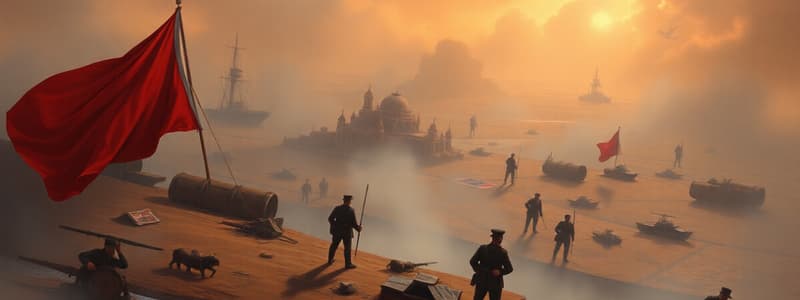Podcast
Questions and Answers
Which of the following was a primary long-term cause of World War I, contributing to a climate of tension and suspicion in Europe?
Which of the following was a primary long-term cause of World War I, contributing to a climate of tension and suspicion in Europe?
- The policy of appeasement followed by Great Britain and France.
- The complex system of alliances that obligated nations to defend one another. (correct)
- The rise of isolationist policies in the United States.
- Widespread adoption of laissez-faire economic policies.
What was the main strategic goal behind Germany's Schlieffen Plan at the outset of World War I?
What was the main strategic goal behind Germany's Schlieffen Plan at the outset of World War I?
- To quickly defeat France before Russia could fully mobilize its forces. (correct)
- To secure Germany's eastern border against a potential Russian invasion.
- To establish naval dominance in the Atlantic Ocean.
- To economically blockade Great Britain into submission.
How did trench warfare primarily impact the progression and nature of combat during World War I?
How did trench warfare primarily impact the progression and nature of combat during World War I?
- It led to a fluid and constantly changing battlefield environment.
- It resulted in prolonged stalemates and immense casualties with minimal advances. (correct)
- It facilitated rapid territorial gains due to enhanced mobility.
- It promoted a higher standard of living for soldiers on the front lines.
Which of the following best characterizes the use of unrestricted submarine warfare by Germany during World War I?
Which of the following best characterizes the use of unrestricted submarine warfare by Germany during World War I?
What direct promise did Germany make to entice Mexico into joining World War I on the side of the Central Powers, as revealed in the Zimmerman Telegram?
What direct promise did Germany make to entice Mexico into joining World War I on the side of the Central Powers, as revealed in the Zimmerman Telegram?
Which of the following was NOT a key provision imposed on Germany by the Treaty of Versailles, which contributed to resentment and instability in the interwar period?
Which of the following was NOT a key provision imposed on Germany by the Treaty of Versailles, which contributed to resentment and instability in the interwar period?
How did Russia's involvement in World War I contribute to the conditions that led to the Russian Revolution?
How did Russia's involvement in World War I contribute to the conditions that led to the Russian Revolution?
What specific promise did the Bolsheviks make to gain widespread support among the Russian populace in 1917?
What specific promise did the Bolsheviks make to gain widespread support among the Russian populace in 1917?
What was the primary goal of Lenin's New Economic Policy (NEP) implemented in the Soviet Union after the Russian Revolution?
What was the primary goal of Lenin's New Economic Policy (NEP) implemented in the Soviet Union after the Russian Revolution?
What was the main consequence of Stalin's collectivization of agriculture in the Soviet Union?
What was the main consequence of Stalin's collectivization of agriculture in the Soviet Union?
Flashcards
Militarism
Militarism
Building up a large army and keeping it active to defend or promote interests.
Alliances
Alliances
Agreements between nations to help each other if attacked, often kept secret.
Nationalism
Nationalism
Pride in one’s country and the desire for self-determination.
Imperialism
Imperialism
Signup and view all the flashcards
Schlieffen Plan
Schlieffen Plan
Signup and view all the flashcards
Trench Warfare
Trench Warfare
Signup and view all the flashcards
Unrestricted Submarine Warfare
Unrestricted Submarine Warfare
Signup and view all the flashcards
Treaty of Versailles Provisions
Treaty of Versailles Provisions
Signup and view all the flashcards
Bolshevik Slogan
Bolshevik Slogan
Signup and view all the flashcards
Lenin’s New Economic Policy
Lenin’s New Economic Policy
Signup and view all the flashcards
Study Notes
- Study notes derived from provided World War I and Russian Revolution Study Guide contents
Causes of World War I (MANIA)
- Militarism: The buildup of a large and active army to defend or promote national interests.
- Alliances: Agreements between nations to provide mutual assistance if attacked, often kept secret.
- Nationalism: Pride in one’s country and the desire to unite people of common languages/ethnicities.
- Imperialism: Domination of one country over another through colonies and spheres of influence, leading to competition.
- Assassination: The assassination of Archduke Franz Ferdinand by a Serbian nationalist was the immediate trigger.
Allied and Central Powers
- Allied Powers (Beginning): France, Russia, Great Britain, Serbia. The United States joined in 1917.
- Central Powers: Germany, Austria-Hungary, Ottoman Empire.
Two-Front War and the Schlieffen Plan
- A two-front war involves fighting enemies located on opposite sides/borders of a country.
- Schlieffen Plan: Germany's strategy to attack France first, then Russia, anticipating Russia's slow mobilization.
Impact of Trench Warfare
- Trench warfare resulted in a stalemate and massive casualties on both sides of the conflict.
New Technology in World War I
- New technologies included machine guns, artillery, poison gas, tanks, and airplanes.
Unrestricted Submarine Warfare
- Unrestricted submarine warfare: Germany's policy of using submarines to attack any ships in open waters.
- Germany used this to blockade Great Britain.
United States Entry into World War I
- Factors for US entry: Germany’s unrestricted submarine warfare, including the sinking of the Lusitania (which carried Americans).
- Zimmerman Telegram: Germany promised Mexico land lost to the U.S. if Mexico joined the war against the Allies.
End of World War I
- November 11, 1918: An armistice was signed between Germany and the Allies to end the fighting.
Treaty of Versailles
- Germany was forced to accept full responsibility for the war.
- Germany had to pay reparations to Britain, France, and Belgium for damages.
- Germany lost land and colonies.
- Germany's military size was restricted, and weapons manufacturing was prohibited.
New Nations After World War I
- New nations created from former European empires: Poland, Estonia, Latvia, Lithuania, Czechoslovakia, Yugoslavia, Finland.
World War I and the Russian Revolution
- World War I contributed to the Russian Revolution due to food shortages, lack of industrial capacity and losing the war.
Bolshevik Support
- The Bolsheviks gained support by promising "Peace, Land, and Bread".
- This included exiting the war, redistributing land, and resolving food shortages.
Lenin’s Government
- Lenin established a Communist state.
- The new government was called the Union of Soviet Socialist Republics (USSR).
- It was a one-party dictatorship.
Lenin’s New Economic Plan
- The New Economic Plan (NEP) aimed to strengthen the Soviet economy.
- It allowed limited private business (capitalism) to stimulate industry.
Czarist and Stalinist Governments
- Both the Russian Czars and Joseph Stalin had authoritarian governments.
- An authoritarian government is defined by one person having full authority/control.
Collectivization of Agriculture
- Stalin ordered the collectivization of agriculture.
- Private farms were replaced with state-owned and managed "collectives".
Problems of Collective Farms
- Collective farms led to massive food shortages and famine, especially in Ukraine.
Stalin’s Treatment of Dissidents
- Stalin executed or exiled opponents to Siberia (in gulags).
- Gulags were forced labor camps.
Studying That Suits You
Use AI to generate personalized quizzes and flashcards to suit your learning preferences.




